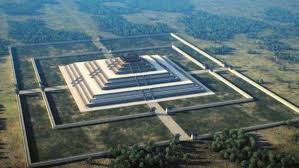
Why Not Excavate Qin Shi Huang's Mausoleum?
Qin Shi Huang, the first emperor of a unified China, left behind a legacy shrouded in mystery and grandeur – his colossal mausoleum. While the Terracotta Army guarding the tomb's periphery has captivated the world, the emperor's final resting place remains untouched by archaeologists. This deliberate decision stems from a confluence of factors, primarily concerning the safety of those involved and the preservation of the historical treasure trove within.
Rivers of Mercury and the Threat to Life
Ancient texts, particularly the Records of the Grand Historian by Sima Qian, provide a glimpse into the potential dangers lurking within the mausoleum. Sima Qian describes a simulated cosmos within the tomb, complete with "rivers of mercury" representing the celestial waterways. This account is supported by significant mercury anomalies detected in the soil above the burial mound.
Exposure to even small amounts of mercury can lead to severe health problems, affecting the nervous system, kidneys, and lungs. Inhaling mercury vapor, which is colorless and odorless, can be quickly fatal. Given the sheer scale of mercury described, potentially hundreds of tons, excavating the mausoleum poses an immediate and grave danger to archaeologists, workers, and even surrounding communities.
Safe removal and containment of such a massive quantity of mercury would be a monumental challenge, requiring unprecedented technological advancements and meticulous safety protocols. The potential environmental impact from accidental release further amplifies the risks involved.
Lethal Traps and the Emperor's Defense
Adding another layer of complexity to the equation are the booby traps described in historical texts. Sima Qian mentions "crossbows rigged to shoot anyone who dares to enter." While the exact nature and sophistication of these mechanisms remain unknown, their potential lethality cannot be discounted.
Excavating the mausoleum would necessitate navigating a potential minefield of ancient booby traps. The slightest miscalculation could trigger these deadly defenses, endangering the lives of those involved.
Preservation for Future Generations
Beyond the immediate dangers, there is a strong argument for preserving the mausoleum undisturbed for future generations. Archaeological techniques are continually evolving, and what seems impossible today might become routine in the future. By delaying excavation, we allow future generations with more advanced technology and a deeper understanding of the past to safely unravel the mysteries of Qin Shi Huang's tomb.
Q&A
Q: Could the mercury within the tomb be safely extracted without endangering human life?
A: While theoretically possible, it would require significant technological advancement and meticulous planning. The sheer volume of mercury, coupled with the unknown layout of the tomb, makes safe extraction a daunting and potentially dangerous undertaking.
Q: Have any attempts been made to explore the mausoleum using non-invasive methods?
A: Yes, archaeologists have employed various non-invasive techniques, such as ground-penetrating radar and magnetic imaging, to map the tomb's structure and contents. These methods provide valuable insights without disturbing the tomb itself.
Q: When do you think it will be safe and ethical to excavate Qin Shi Huang's tomb?
A: It's difficult to pinpoint a specific timeframe. It depends on advancements in robotics, mercury remediation, and our understanding of ancient Chinese booby trap mechanisms. Ultimately, the decision to excavate should prioritize the safety of individuals and the preservation of this invaluable historical site.